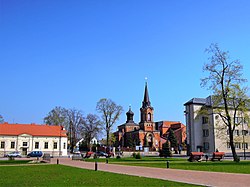

In Lithuania, there are 103 cities (miestai). The term city is defined by the Parliament of Lithuania as a compact urban area with more than 3,000 people, of whom at least two-thirds work in the industry or service sector. Settlements with a population of less than 3,000 but with historical city status are still considered to be cities. Smaller settlements are known as towns (miesteliai), and even smaller settlements are known as villages (kaimai). Often the official status of these smaller settlements are unclear, and people simply refer to both towns and villages as settlements (gyvenvietės).
Contents
- Cities with over 50,000 inhabitants
- Cities between 20,000 and 50,000 inhabitants
- Cities between 5,000 and 20,000 inhabitants
- Cities between 1,000 and 5,000 inhabitants
- Remaining cities in Lithuania
- Map of Lithuanian cities by population
- Gallery
- Cities by compass direction reference
- See also
- Notes and sources
- References
The cities started to form between the 13th and 14th centuries together with the Grand Duchy of Lithuania. The first to receive city rights was Klaipėda. According to medieval law, a city could have its own fairs, taverns, guilds, courts, etc. Some former cities lost their status and are now just towns or villages, for example Kernavė and Merkinė. Most of the cities in Lithuania were established before the 18th century. Their location is mostly determined by trade and transportation routes. Some of the newer cities grew because of railroad construction, for example Kaišiadorys, Vievis, Radviliškis, Ignalina and Mažeikiai. In the 20th century, new cities grew primarily to service state developed industrial complexes, for example Visaginas, Elektrėnai and Naujoji Akmenė.
Of over 100 cities, only 14 have populations of over 20,000. Five cities (Birštonas, Druskininkai, Neringa, Palanga and Anykščiai) have a special resort status. Cities are quite evenly spread out through the territory of Lithuania. At the 2001 census, 66.7% of the population lived in cities. At the 2021 census the proportion had increased slightly to 68.2% of the population.






















